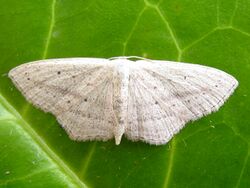Biology:Scopula emutaria
From HandWiki
Short description: Species of geometer moth in subfamily Sterrhinae
| Rosy wave | |
|---|---|

| |
| Scientific classification | |
| Domain: | Eukaryota |
| Kingdom: | Animalia |
| Phylum: | Arthropoda |
| Class: | Insecta |
| Order: | Lepidoptera |
| Family: | Geometridae |
| Genus: | Scopula |
| Species: | S. emutaria
|
| Binomial name | |
| Scopula emutaria | |
| Synonyms | |
| |
Scopula emutaria, the rosy wave, is a species of moth in the family Geometridae. It is found in western and south-western Europe and Romania. Also in North Africa.[3]
The wingspan is 23–26 millimetres (0.91–1.02 in) (sometimes 20–24 millimetres (0.79–0.94 in)). Easy to distinguish by its whitish ground-colour, slight or rather strong pink flush. Most striking is the straight broad line over the wing towards the wing tip.[4][5]
Adults are on wing from June to July.[6]
It is a coastal species. The larvae feed on sea beet and Armeria maritima.[7]
Subspecies
- Scopula emutaria emutaria
- Scopula emutaria subroseata (Haworth, 1809)
References
- ↑ "Scopula (Calothysanis) emutaria (Hübner, 1809)". Fauna Europaea. 29 August 2013. http://www.faunaeur.org/full_results.php?id=444384. Retrieved 16 April 2017.
- ↑ Sihvonen, Pasi (April 1, 2005). "Phylogeny and classification of the Scopulini moths (Lepidoptera: Geometridae, Sterrhinae)". Zoological Journal of the Linnean Society 143 (4): 473–530. doi:10.1111/j.1096-3642.2005.00153.x.
- ↑ Prout, L.B. 1912–16. Geometridae. In A. Seitz (ed.) The Macrolepidoptera of the World. The Palaearctic Geometridae, 4. 479 pp. Alfred Kernen, Stuttgart.
- ↑ Peder Skou (1986). Leif Lyneborg. ed (in da). The Geometroid Moths of North Europe (Lepidoptera: Drepanidae and Geometridae). 6. E.J. Brill/Scandinavian Science Press. p. 48. ISBN 978-9004078598. https://books.google.com/books?id=cdwUAAAAIAAJ&pg=PA48&dq=Scopula+emutaria.
- ↑ Meyrick, E., 1895 A Handbook of British Lepidoptera MacMillan, London pdf
 This article incorporates text from this source, which is in the public domain. Keys and description
This article incorporates text from this source, which is in the public domain. Keys and description
- ↑ UKmoths
- ↑ Moths and Butterflies of Europe and North Africa
External links
Wikidata ☰ Q171286 entry
 |


